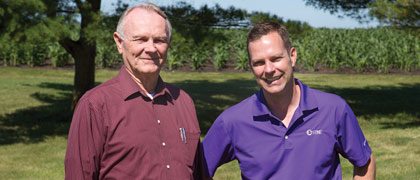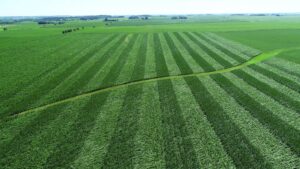Twenty years after being awarded the first-ever U.S. soybean patents, America’s largest privately-owned seed company continues to innovate.
Farmers in the United States planted a record 84.8 million acres of soybeans this spring, according to the U.S. Department of Agriculture. And the majority of those soybeans planted, at least 60 percent, use genetics developed by one man.
In an industry increasingly dominated by a handful of major players who’ve emerged as victors after years of consolidation, 72-year-old Harry Stine of Adel, Iowa, stands in a class of his own.
Stine Seed Company, which Harry’s father originally founded in the 1950s as Stine Seed Farm, and its affiliates now own more than 800 patents, at least 750 of which are directly related to soybeans. Stine employs nearly 400 people in 16 states. It’s America’s largest privately-owned seed company, and the fourth largest seed company overall.
FORBES estimates that Stine’s company, which also breeds corn genetics, is worth nearly $3 billion. Harry Stine is now reportedly the wealthiest man in Iowa.
Hard to believe such big things could stem from something as small as a seed.
“My father is a genius with genetics,” says Harry’s 42-year-old son Myron, who serves as vice president of sales and marketing for Stine Seed Company. “He thoroughly loves to improve genetics, specifically with regard to yield and performance of field corn and soybeans.”
In 1965, Harry Stine was a 23-year-old farm employee who became interested in soybean breeding after finding some unusual soybean plants growing in one of his father’s fields. Stine saw the value and additional profit opportunities that breeding, developing and growing newer, higher-yielding soybean varieties would have for his company, as well as farmers. While yield-checking the soybean lines, he came to understand what a conventional breeding program could bring to the soybean industry and to growers.
At the time, soybean breeding in the U.S. was done strictly by universities. Harry Stine began a soybean breeding program with four other seedsmen — the first of its kind. Retail soybean seed sales efforts began in 1979, when Stine began selling soybean seed under his own label, Stine Soybean Seeds. In 1992, in addition to being one of the top four soybean seed companies in the U.S., Stine began selling corn and soft red winter wheat under the Stine label.
Harry and Myron Stine of Stine Seed Company in Adel, Iowa, work to deliver improved soybean and corn genetics to the marketplace.
Building A Legacy
It’s his soybean and corn breeding efforts that have made Harry Stine so renowned within the industry. In 1994, Stine Seed Company became the first company in U.S. history to receive a patent on soybean varieties. “My father had the foresight to know that if he was going spend all this time and energy developing genetics, he had better protect them,” Myron says. He now sells his prized soybean and corn genetics to many of the industry giants.
Stine’s soybean seeds are now hugely sought-after, and the approximately 12 companies under the Stine umbrella work with all the industry heavyweights to conduct research and bring new products to market.
“We work with practically every company out there that’s in the corn and soybean market,” Myron says. “As a smaller, privately-held company, it’s advantageous for us to have those connections with the many research companies we do. Without those connections, we have less knowledge of our products and less to offer our customer base.”
Stine Seed is unique relative to some of the bigger, globally-known brands. “There’s a market out there that likes what we represent — a family-based, moderately large seed company,” Myron says. “That brings a lot of opportunity.”
Because of the revolutionary breeding work started by Harry Stine, the Stine brand will now have access to practically every new herbicide trait platform that will be available in the near future, Myron notes. “We are the only company involved with each soybean trait platform available for mid-decade release,” he says.
Stine works with research institutions around the United States to conduct soybean research — the sort of research that’s led to this year’s record of 84.8 million acres of soybeans planted in the U.S., up 11 percent from last year.
“Part of that jump is due to improved genetics,” says Laura Lindsey, Ohio State University Extension soybean specialist. She’s worked with Stine Seed in her research and agrees that Stine is a familiar name because so many of today’s soybean genetics originate with one family business. “They’re unique that way,” she says.
On the corn side, Stine has a number of new high-yield genetics under development. Harry Stine hopes to revolutionize how corn is grown, and thereby double world corn output. He has bred corn to grow at a higher density with shorter plants and leaves that attract more sunlight. Additionally, this corn can be planted in narrower rows, significantly increasing yields.
“That’s bringing a very new twist to hybrid corn production, which is a lot of fun,” Myron says. “It’s not simply taking corn hybrids and planting them thicker. It’s actually changing the genetics to work in that environment.”
Growing The Future
It’s no secret that soybean acreage is on the rise in the U.S. In addition to improved genetics, Lindsey says the industry also has Mother Nature to thank for that. “Soybeans are very profitable. That’s a huge reason for the boom,” she says. “In Ohio, we had some farmers switch from corn to soybeans this year because it was so wet. We’ve just had so much rain, especially in central Ohio, that farmers felt like planting late with corn was going to be much less profitable than planting late with soybeans — so they planted soybean after soybean.”
Whether it’s the weather or the benefits of improved genetics, Stine will only continue to benefit from the rise of the soybean. There are some challenges ahead, though. “Deregulating the new trait platforms has taken much longer than anyone ever anticipated,” Myron says.
Still, Stine Seed Company has to plan for the future, and can’t wait around for those new traits to be approved before it does so. “It’s tough, but there’s no real strategy for it,” Myron adds. “It’s about planning — determining the probability that, something will be deregulated so you can market it and make sure you have production where it needs to be.”
Marc Zienkiewicz















